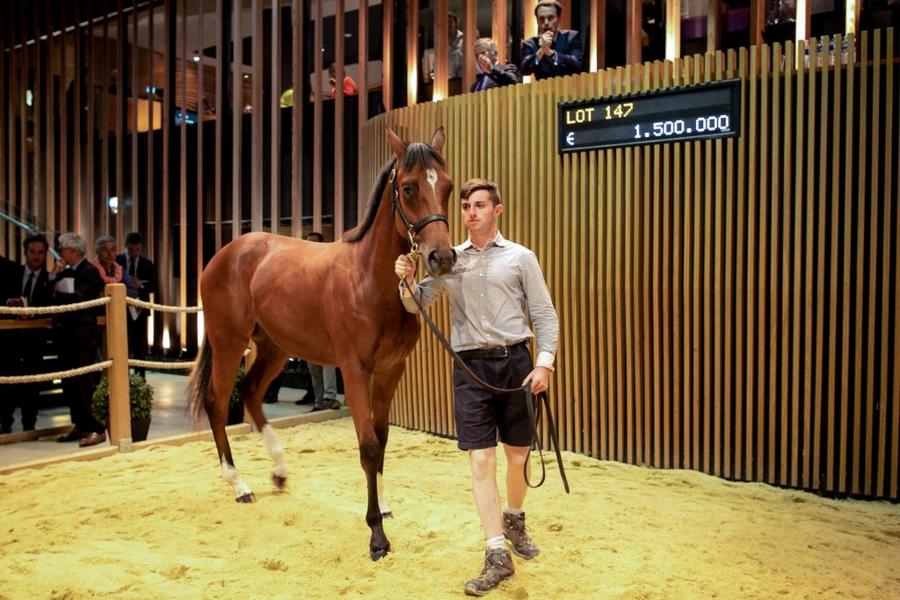In the world of elite horse racing, winning the Kentucky Derby might make headlines—but it's what happens after retirement that really brings in the big bucks. Welcome to the unbelievably lucrative world of stud fees, where the best stallions earn more money breeding than they ever did racing. These equine icons don't just retire to greener pastures—they retire to five-star breeding barns, collecting hundreds of thousands of dollars per session for doing what nature intended… over and over again.
Here's a deep dive into the most profitable stallions in history, the economics behind breeding, and the jaw-dropping numbers that prove these horses get very well paid for getting laid.
How Stud Fees Work
When a male racehorse (a stallion) retires to stud, he's made available for breeding with broodmares (female horses). The owners of those mares pay a stud fee—which can range from a few thousand dollars to over $400,000 per cover—for the chance to produce the next champion.
Most top stallions service 100 to 200 mares per year, depending on health, demand, and fertility. Multiply that by the per-session fee, and you'll see how a horse can earn tens of millions annually—without ever stepping back on a track.
The Five Highest Earning Stallions in History
#1: Galileo – The $300 Million Legend
Stud Fee (Peak): €400,000 (~$450,000)
- Years at Stud: 2002–2020
- Est. Annual Earnings: $60–80 million
- Lifetime Stud Earnings: $250–300+ million
The crown jewel of Coolmore Stud, Galileo was more valuable off the track than on it—and he was a world-class racer to begin with. He sired over 90 Group 1 winners, including Frankel, Australia, and Minding. His bloodline became the foundation of modern European racing. Galileo passed away in 2021, but his legacy—and revenue stream—continues through his sons at stud. For example, pictured below is a one-year-old colt sired by Galileo, who was acquired for 1.5 million Euros at auction in August 2019.

(LOU BENOIST/AFP via Getty Images)
#2: Tapit – America's $200 Million Powerhouse
- Stud Fee (Peak): $300,000
- Years at Stud: 2005–present
- Est. Lifetime Earnings: $200 million+
A dominant force in American racing, Tapit has sired multiple Belmont Stakes winners and Breeders' Cup champions. His sons and daughters are known for their speed and stamina—and his consistent results made him the most in-demand stallion in the U.S. for over a decade.
- Frankel – The $400K British Phenom
- Stud Fee (2024): £350,000 (~$440,000)
- Standing At: Juddmonte Farms
- Career: Undefeated in 14 starts
A direct son of Galileo, Frankel has inherited the throne. His fee recently rose to £350,000, making him one of the most expensive stallions in the world today. With a limited number of covers per year (around 130), he's likely bringing in $50–60 million annually, and growing.
#3: Deep Impact – Japan's $150+ Million Breeding Titan
- Stud Fee (Peak): ¥40 million (~$375,000)
- Years at Stud: 2007–2019
- Lifetime Stud Earnings: $150 million+
The most successful stallion in Japanese racing history, Deep Impact sired dozens of Group 1 winners across Asia and Europe, including Derby winners, Arc contenders, and Japan Cup champions. He died in 2019, but remains a national legend—and a billion-yen investment that paid off in spades.
#4: Storm Cat – The Original $100 Million Stud Fee Rockstar
- Stud Fee (Peak): $500,000
- Years at Stud: 1988–2008
- Lifetime Stud Earnings: $100M+
In the 1990s and early 2000s, Storm Cat was the gold standard. Despite inconsistent race success from his offspring, his bloodlines were irresistible to breeders. For several years, he was the most expensive stallion in the world. While he didn't match the long-term success of Galileo or Tapit, he made a fortune for his owners before retiring from stud duty in 2008.
#5: American Pharoah – The $70 Million Crown Jewel
- Stud Fee (Initial): $200,000
- Syndicated For: $70 million
- Standing At: Ashford Stud (Coolmore USA)
After winning the Triple Crown in 2015, American Pharoah was quickly syndicated and retired with a valuation around $70 million. In his first few seasons, he bred over 100 mares per year, bringing in $20 million annually at his peak. While his fee has since dropped, he remains a marquee name in U.S. breeding.
The Economics of Equine Royalty
Breeding isn't just a lucrative retirement plan—it's the backbone of the thoroughbred industry. A Derby or Triple Crown win is a launchpad into generational wealth. For stallions, every mare bred is a chance to replicate greatness—and rake in another six figures.
For owners, it's not uncommon to make $10 to $30 million per year from a top-tier stallion. And if that horse passes on his traits successfully? The fee goes up—sometimes dramatically.
Final Gallop
While the races may be the public spectacle, the real business of horse racing begins in the breeding shed. A great stallion can earn more in one breeding season than he did in an entire racing career. And the elite few—like Galileo, Tapit, and Frankel—go down not just as champions, but as multi-generational money machines.
They're not just horses—they're empires on four legs.
/2015/06/american.jpg)
/2016/02/GettyImages-476222206.jpg)
/2015/06/zayat.jpg)
/2011/05/bob-baffert-1.jpg)
/2015/09/GettyImages-482792350.jpg)
/2015/06/horse.jpg)
/2018/03/GettyImages-821622848.jpg)
/2020/06/taylor.png)
/2009/09/Jennifer-Aniston.jpg)
/2020/02/Angelina-Jolie.png)
/2020/01/lopez3.jpg)
/2019/11/GettyImages-1094653148.jpg)
:strip_exif()/2009/09/P-Diddy.jpg)
/2009/11/George-Clooney.jpg)
/2009/09/Brad-Pitt.jpg)
/2019/10/denzel-washington-1.jpg)
/2009/09/Cristiano-Ronaldo.jpg)
/2017/02/GettyImages-528215436.jpg)
/2020/04/Megan-Fox.jpg)
:strip_exif()/2015/09/GettyImages-476575299.jpg)
/2019/04/rr.jpg)